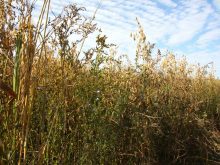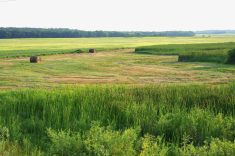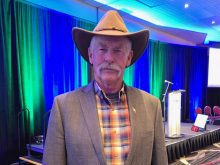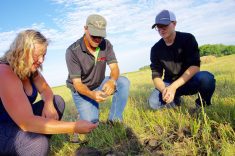Producers pay a lot of attention to inputs, seeding rates and combine settings to expand profit margins. According to ag entomology experts, they should also pay attention to pollinator populations and diversity.
That means more than honeybees. In Saskatchewan, there are up to 400 different species of bees that contribute as pollinators. Manitoba counts well over 300 bee species, from leafcutters to bumblebees to tiny sweat bees. Then there are all the beetles, flies, moths and butterflies.
“About 20 per cent yield increase with a really robust population of pollinators would be a pretty good estimate for yield increase with pollinators, maybe down to 10 per cent or even five (with less population),” said Graham Parsons, a pollinator biosecurity specialist with the Saskatchewan agriculture department, during the Melfort Crop Diagnostic School.
Read Also

Still hard to predict precise fertilizer payback
Despite decades of advances, international research finds no clear answer for where and when adding nutrient will fail to boost growth.
“A lot of producers, if you’d say they could get five, 10, 15, or 20 per cent more yield for canola, they’d crawl over broken glass to do that. Well, what you’re going to have to do is provide some protection or provide some pollinator habitat for pollinators to allow that to happen.”
Why it matters: More bugs in the field can be a good thing if they’re yield-boosting pollinators and pest-eating predators.
Any crop with flowers will benefit from pollinators. Canola, faba beans, coriander, caraway, lentils, peas and forage are quite pollinator dependent, he said.
Producers can make their fields more pollinator friendly without a lot of work, Parsons added.
“Having wetlands and woodlands and shelter belts and stuff going around your farm or leaving maybe a strip against the edge of the road between power poles and along fence lines are beneficial for those beneficial insects around the space.”
There is no reason to sacrifice yield for the sake of pollinator-boosting practices, he added. Converting a small area for pollinators doesn’t reduce net yield, even if a few productive acres are involved. The pollinator benefit can make up the difference, with some to spare.
Cover crops or a diverse blend of flowering species planted nearby can also help. The diversity of environment will keep existing pollinators nearby and attract more. No-till and minimal ground disturbance are also pollinator-friendly practices because they maintain habitat.
“Seventy per cent of the pollinators are (living) in the ground. The other 30 per cent would be in sticks and logs and stems and woody materials,” said Parsons.
Be kind to the bugs
Habitat is not enough to keep pollinators safe and welcome. Parsons stressed the importance of keeping pollinators in mind during spray season. Herbicides as well as insecticides are part of that equation. Spraying is still on the table, but some products are less damaging to pollinators.
Spray timing also matters. Insects are less active in early morning and evening. Those periods also bring the highest risk of drift if the producer isn’t careful.
“Most of our pollinators are foraging during the heat of the day. So, sunlight to bright sunlight and kind of 15 degrees Celsius is kind of a good low limit,” he said.
Some bumblebees might be out at lower temperatures, but spray applied at 12-15 C has a much lower chance of inflicting damage.
Meghan Vankosky, a field crop entomologist with Agriculture and Agri-Food Canada, added that not every herbivorous insect is a pest. There are also predatory beneficial insects to consider, which would benefit from more pollinator friendly spray practices.
















